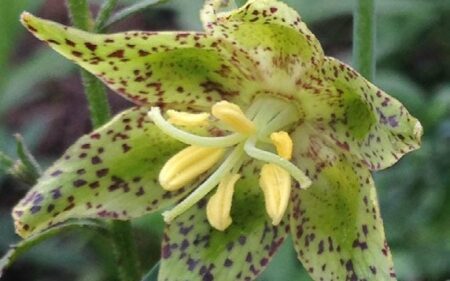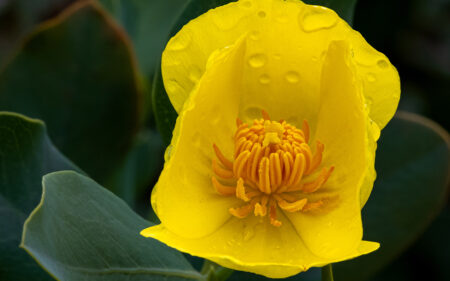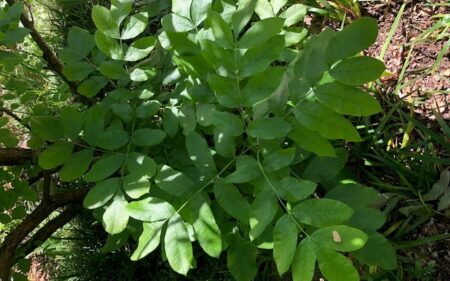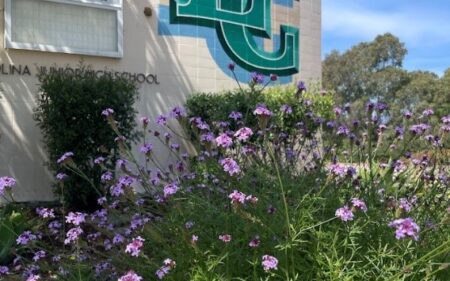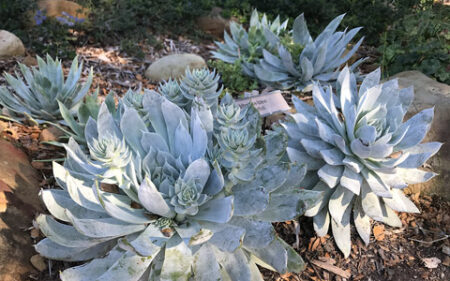Can Oak Trees Provide a Natural Fuel Break?
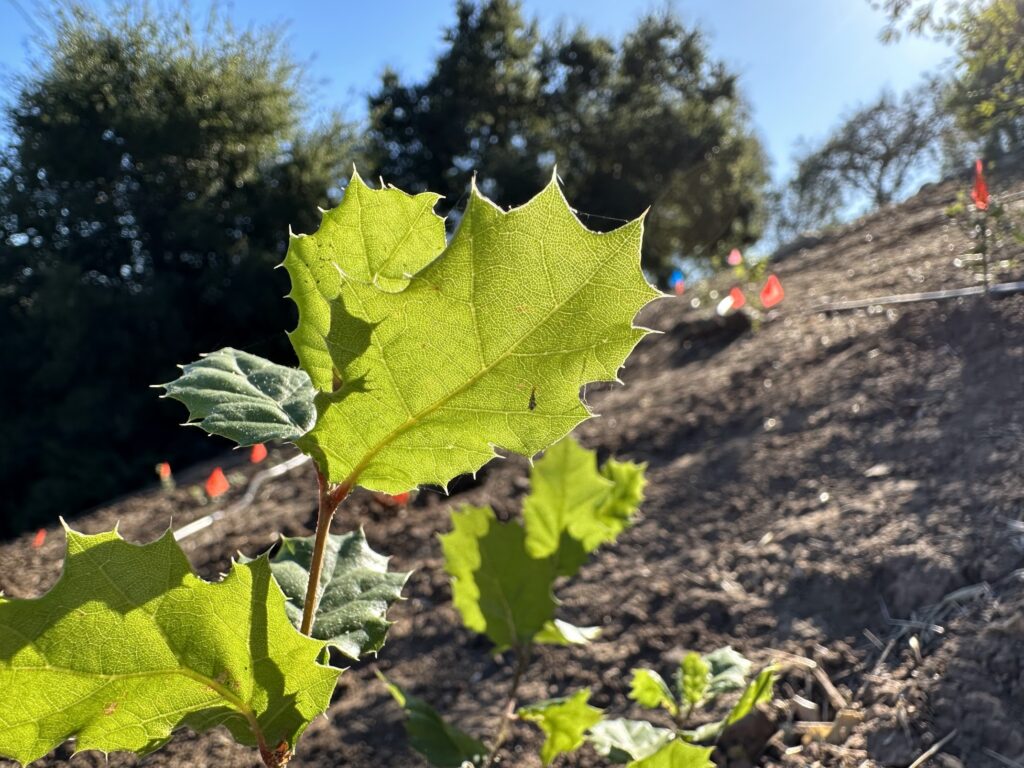
The amount and types of plants present in a landscape play a crucial role in how fire travels from one area to the next. Although a lack of plants can help stop fire from traveling, it’s in our best interest to maintain biological diversity and provide slope stabilization. That’s why Santa Barbara Botanic Garden is researching how native plants can help better manage fire risks.
Have you ever seen a cleared strip of land on a ridge top? These are called “fuel breaks” and if you’re like me, you may have wondered if there could be a better way. When we hear we need to “save the trees,” it seems counterintuitive to clearcut vegetation. Despite this, clearcutting is what many land management agencies do to manage wildfire risks. While there are benefits to this method, there are some drawbacks too.
These fuel breaks can help stop the spread of wildfires and give firefighters defensible space by removing the plant material that provides fuel. However, clearcutting vegetation harms native vegetation and biodiversity and it disturbs soils that hold our slopes in place. It can also provide a breeding ground for invasive plants that often burn readily and more easily spread fire. To find a better solution, the Garden is researching an alternative that involves planting more trees—and we’re trialing this right inside the garden grounds.
The Mighty Oak May Be Even Mightier
Many scientists and firefighters believe that it’s possible for us to have it all (habitat, aesthetics, AND fire safety) thanks to shaded oak (Quercus spp.) fuel breaks. The Garden is setting out to test and demonstrate this.
Anecdotal evidence suggests that stands of oak trees can mitigate or slow wildfires through several measures. First, many oaks, including the Coast Live Oak (Quercus agrifolia) retain moisture throughout the entire year, while other plants may dry out and become wildfire fuel in the dry season (Pirsko and Green 1967). Next, oak trees can shade out invasive annual plants with their dense canopy and leaf droppings, leading to reduced presence of invasive annuals that more readily catch fire. What’s more, they are unparalleled at providing habitat. It is pretty remarkable that mature oak trees provide the services of weed control and fire risk reduction, two tasks that would take land managers a lot of resources to achieve. While oaks are slow-growing and require some initial work to establish, I’d say it may be worth the wait.
Stands of oak trees also provide shelter from wind. Less wind helps to keep fire from spreading and becoming more intense. Finally, some studies suggest that Coast Live Oaks increase fog drip, changing moisture levels in the soil that surrounds them, further reducing the chance for wildfires to spread (Wells 1962). Another way this oak species really shines is in its ability to resprout after a fire (Ackerly et al. 2019). With its thick bark that protects the layer of wood that is responsible for putting on new growth, this tree species is able to resprout vigorously after fires, allowing oak habitat to prevail (Plumb 1980).
How We’re Researching Oak Fuel Breaks?
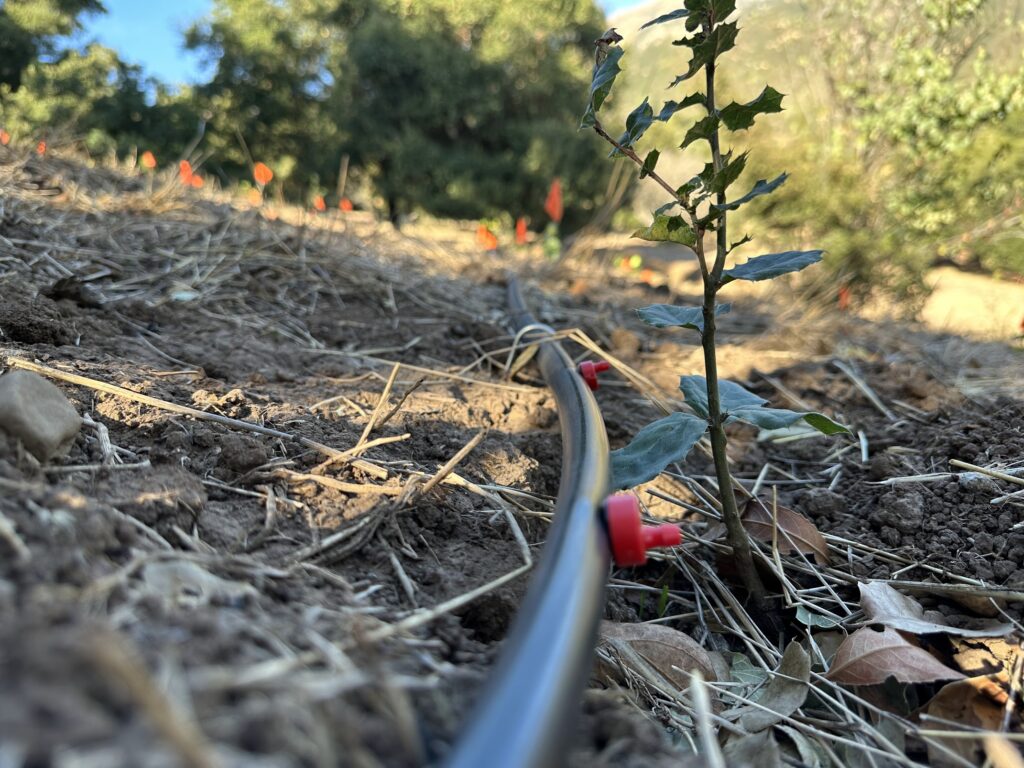
Now that I have sufficiently sung my praises for the mighty Coast Live Oak tree, I can explain how this idea is being explored at Santa Barbara Botanic Garden.
In 2022, the Garden obtained funding from the Santa Barbara Regional Wildfire Mitigation Program’s (RWMP) Landscape Domain to help install a shaded oak fuel break on a hot sunny slope on the eastern side of the garden. With the help of our staff, volunteers, there are now 216 oak saplings beginning to get established on this steep hillside.
The goal for this project is for these trees to grow up and provide a much-needed wildfire buffer for the Garden and the surrounding community. Fuel breaks in the urban-wildland interface (where wild areas meet urban communities), are key because they are both high-risk ignition areas and support human residents. The oak fuel break we have worked to implement in the Garden will serve as a living wildfire buffer for decades to come.
To give proof to the concept of oaks being used as fuel breaks, Garden scientists will test the anecdotal evidence of oak wildfire resiliency. In the near term, we’ll compare temperature, relative humidity, soil moisture, and wind data—all important variables for wildfire—from the slope where the oaks are planted and compare this with two other areas in the Garden. One area is a similarly east-facing slope that already has dense oaks, and the other is an open ridge. Over time, we’ll continue to monitor these variables on at least our test slope as the oaks mature. The Garden is also collaborating with Spatial Informatics Group-Natural Assets Laboratory, the non-profit leading RWMP Landscape Domain efforts, to map baseline hillslope environmental conditions and study variations in hillslope-scale microenvironmental conditions relating to terrain position and vegetation cover.
In addition, because it is important to achieve the highest survival and fastest growth that we can, we are also conducting research on two variables for oak establishment: irrigation and seedling age. Some of the oaks we are planting are about a year old, while others are nearly two years old. While the older plants are typically larger, the younger plants might have a long-term advantage, as their roots have not yet been constrained in their pots.
Finally, we are also testing how important supplemental water is to survival and growth. In our experimental design, half the oaks will be watered only in the month following planting, while the other half will receive supplemental watering for the first year after planting. By testing these variables, we will be able to determine best practices and inform future oak plantings. Furthermore, this grove will serve as a demonstration to our many visitors in the future.
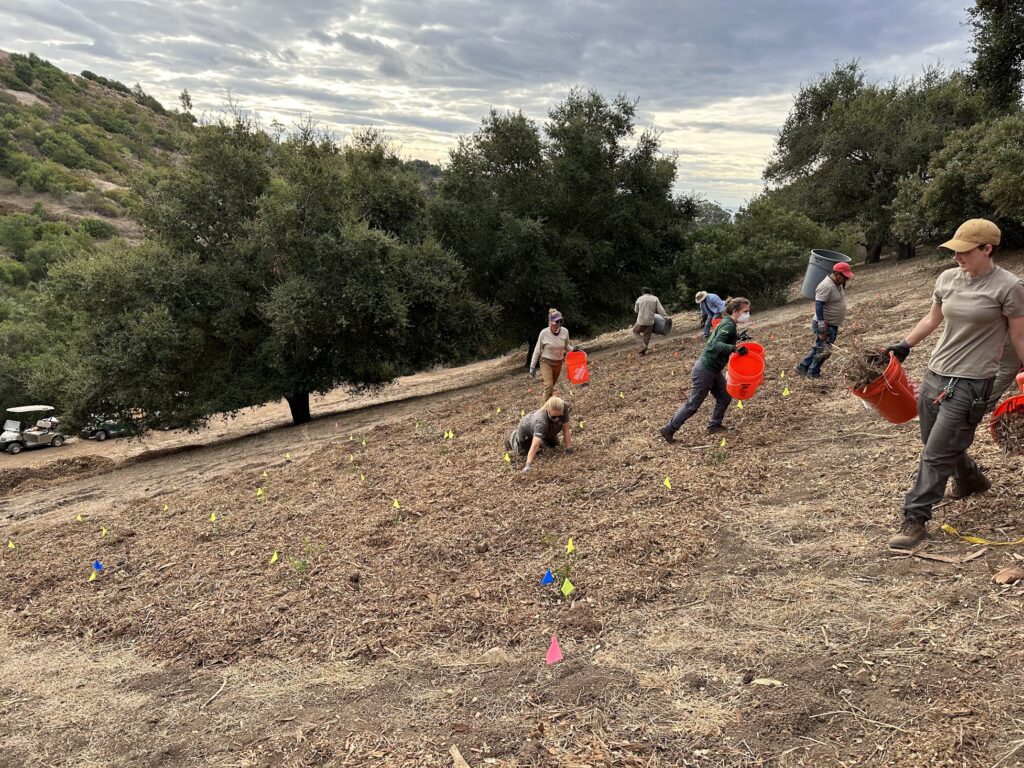
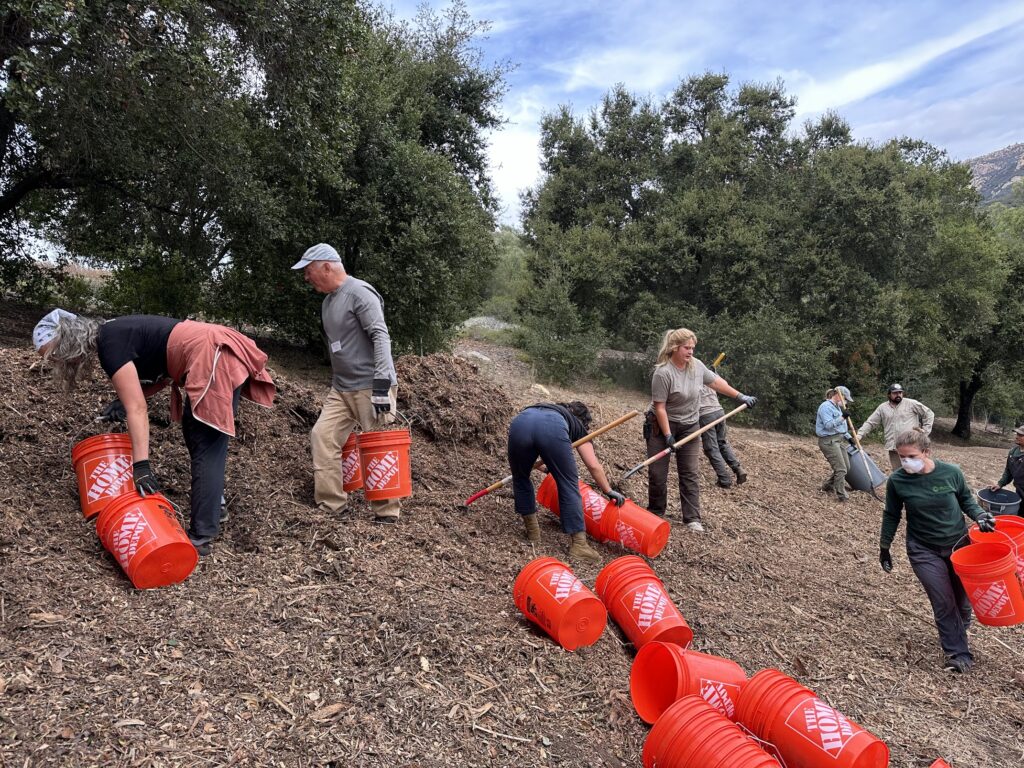
Community Resources for Fire Management
Since 2013, the Garden has guided our community’s understanding of fire danger data in the form of Live Fuel Moisture data. Live Fuel Moisture measurements reflect the available fuel in a plant at a given point in time at a given location to inform the risk of wildfire ignition and spread. We’ll continue to provide this community service for the foreseeable future.
As a garden that sits on the Wildland Urban Interface and is part of a larger community that faces risks of wildfire, it is our duty to be good stewards and contribute to the research of wildfire mitigation. If you are interested in learning more about how you can buffer your property from wildfires with native plants, please check out these fire-wise landscaping resources from our friends at Theodore Payne Foundation and Sustainable Defensible Space.
Watch Our Oak Stand Grow in the Garden
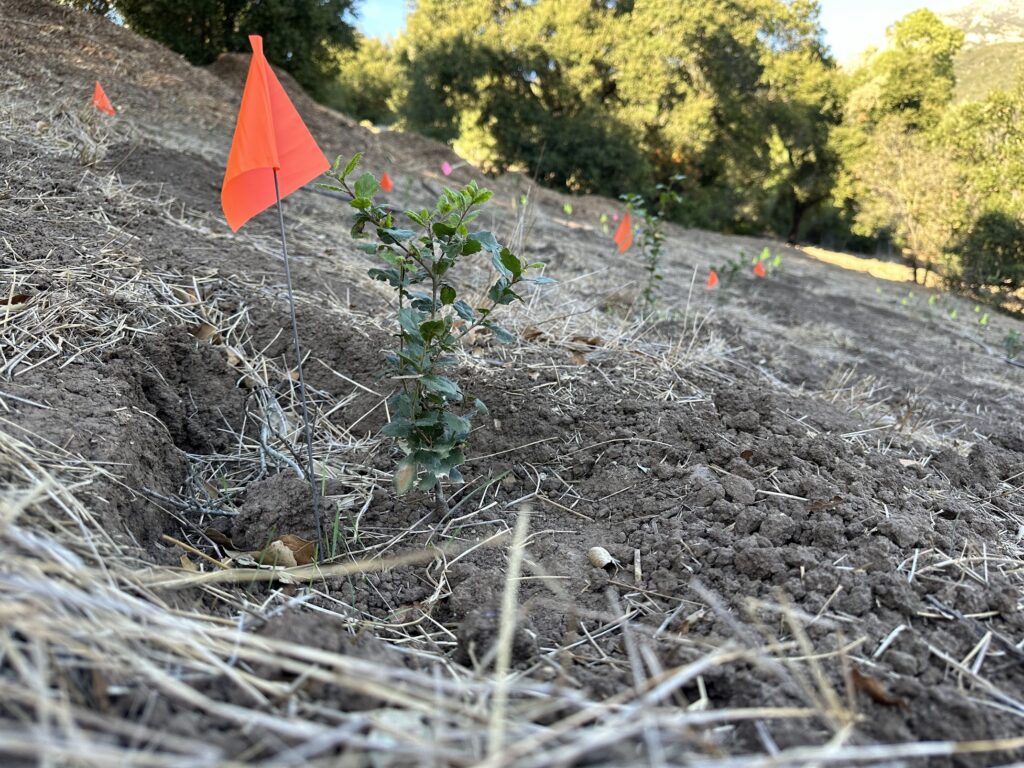
I also encourage you to take a look at our young Coast Live Oak trees just north of the Pritzlaff Conservation Center once the Tipton Trail opens next year. The new trail will take you right by our shaded oak fuel break project area so you can watch as these small saplings grow over the years to come.
Citations:
Ackerly, D. D., Kozanitas, M., Papper, P., Oldfather, M., & Clark, M. (2019). Mortality and resprouting in California oak woodlands following mixed-severity fire. International Oaks, 30, 23–30.
Pirsko, A.R., & Green, L.R. (1967). Record low fuel moisture follows drought in southern California. Journal of Forestry, 642-643.
Plumb, T. R. (1980). Response of Oaks to Fire. Proceedings of the Symposium on the Ecology, Management, and Utilization of California Oaks, 202–215.
Wells, P. V. (1962). Vegetation in Relation to Geological Substratum and Fire in the San Luis Obispo Quadrangle, California. Ecological Monographs, 32(1), 79–103. https://doi.org/10.2307/1942361
 Donate
Donate